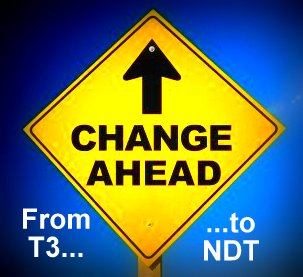There are a variety of reasons we might change over to a different thyroid med. So here’s information to help you, all based on our experiences. And please work with an open-minded doctor. Janie, hypothyroid patient and site creator
From T3 to NDT
Whereas 25 mcg T3 is approximately equal in “effect” to one grain of Natural Desiccated Thyroid (NDT)…based on what patients have read and experienced…
And whereas one grain of most brands of NDT contains 38 mcg T4 and 9 mcg T3 (Canada’s Erfa is 37/8)…
….and if you want to move from T3 to NDT…here’s what patients have learned which you can use in working with your doctor:
1) Patients will drop approximately 10 mcg of T3 (if you are just using the 5 or 10 mcg tablets) or 12.5 mcg of T3 (if you are using the 25 mcg pill) and add a grain of NDT
2) Soon, the 38 mcg of T4 is going to start converting to T3
3) So, in one – two weeks, patients drop another 10 or 12.5 mcg of T3
4) Hold another week or two.
5) Start with #1 above again
Will I feel more hypo in the transition?
Patients have reported there may be periods where you’ll feel more hypo, and have to give the T4 conversion time to catch up. Not everyone feels this.
Shouldn’t I have plenty of cortisol and iron before doing this?
Patients say yes, it’s imperative to know that you have plenty of cortisol and iron when making the switch to make sure the T4 in NDT isn’t going to start converting to extra RT3 over T3.
Which doses of T3 do I start dropping first?
Some work on the latter doses first; others the first morning dose. It’s individual.
Will I end up on the exact equivalent of NDT to the T3 I was on?
Note that the five hormones in NDT makes it work very effectively based on so many patient reports, so patients “may” end up needing less NDT than they think based on the amount of T3 they are on. It will be an experiment based on symptoms, and based on labwork—the latter which we can do once finished transitioning and have held the final amount of NDT for at least two weeks and ideally four weeks.
What do patients notice when they switch to NDT from T3-only?
The most common description is that it’s a far smoother treatment to be on NDT. That may be because you now have T4 converting to T3 for you. Second, patients report simply feeling better than they did on T3 only. And of course, one must have good cortisol and iron levels to achieve this.
From NDT to T3:
This is often done by those who have a high RT3 (reverse T3), or who want to avoid the high RT3 due to an upcoming surgery.
For those who are switching due to high RT3
Note: RT3 is trending high when it’s moving above the bottom three numbers in a range. RT3 is super high when it’s going towards the top area of the provided range. And we find it important to treat the CAUSE of the rising RT3. Read this.
Since one grain of NDT is approximately equal to 25 mcg T3, we drop the one grain (it’s got 80% T4 in it, which is converting to rising RT3), then at the same time, make it up with 25 mcg T3 at the same time we were taking it. As time goes by, the RT3 will drop and drop some more if the NDT is dropped/replaced.
The latter is also the way we do it for dropping more than one grain. Example, if one was taking 2 grains at one time, the switch is to 50 mcg of T3 at that same time. If anyone notices a higher heart rate, they can take the T3 in two doses, such as 25 mcg, then another 25mcg 3-4 hours later.
For those who are switching who don’t have a high RT3 (but switching to avoid the RT3 rise due to an upcoming surgery or stressful event)
Since one grain of NDT is approximately equal to 25 mcg T3, we drop the one grain, allowing several days to go by since the T4 in NDT is still converting to T3, then make it up with 25 mcg T3 at the same time we were taking it. And etc.
In relation to doing the CT3M (the use of T3 in the wee morning hours to bring up the morning cortisol)
The first thing to understand is that many do NOT have to be on “all” T3 to be successful with the T3CM method of treating low cortisol, we’ve noticed. So when a patient states he or she has a strong reason to exchange some of the NDT to T3, they try using T3 just for their CM dose and maintaining NDT during the day.
Or, if patients are exchanging a daytime dose from NDT to T3, they drop the NDT one grain in half, wait approx. several days for some of the conversion of T4 to T3 to start dropping, then replace the half grain with approx. 12.5 mcg T3, then add more as needed every few days until up to approx. 25 mg T3 as a replacement for the one grain NDT that is dropped. It’s all very individual and you have to monitor yourself by your symptoms. Keep in touch with your doctor.
IMPORTANT: the above is not a precise process. It’s approximate. We do recommend staying in touch with a doctor as you go through the switch, just in case.
